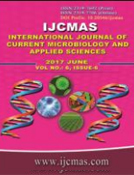


 National Academy of Agricultural Sciences (NAAS)
National Academy of Agricultural Sciences (NAAS)

|
PRINT ISSN : 2319-7692
Online ISSN : 2319-7706 Issues : 12 per year Publisher : Excellent Publishers Email : editorijcmas@gmail.com / submit@ijcmas.com Editor-in-chief: Dr.M.Prakash Index Copernicus ICV 2018: 95.39 NAAS RATING 2020: 5.38 |
The main objective of this paper is to appraise the existing situation of major pulse production and consumption with adoption of technologies and its impact on crop productivity, income, and other socio-economic issues. The average productivity of improved variety of chickpea in adopted villages was estimated at 9.5 quintal/ha & for local variety it was 8.5 q/ha. For pigeon pea the productivity was 18to 19 quintal/ha. The per capita income in the adopted village was more than that of control village accounted 54% of income from the crop enterprises and from pulses its share was estimated only10 to 12percent of total farm income. Human labor accounted highest cost in pulse cultivation (farm family contributed about52 percent of total labor). Comparative cost and benefit analysis indicated that pulse crop were more remunerative in Bihar. Constraints analysis indicates that the non-availability of seeds of high-yielding varieties in the desired quantities was perhaps one of the major constraints followed by moisture stress, high pod borer incidence, and shortage of labor during harvesting and threshing and some of variety found not suitable in flood affected area etc in pulse production. The share of consumption expenditure on pulses was only 15.60 percent of total food expenditure/household. It is suggested that major future expansion of area under pulse crops may take place in rice fallows, (1.2 million ha) where there is no other crop to compete with. Steps to reduce the temporal and spatial variation in price of pulses will definitely help in sustaining as well as enhancing the farmers' interest in pulses production. The government has never treated the MSP as an effective tool for increasing pulses production; High volatility in prices for long periods, low productivity, and stagnation in production technology has acted as disincentives for pulses production.
 |
 |
 |
 |
 |